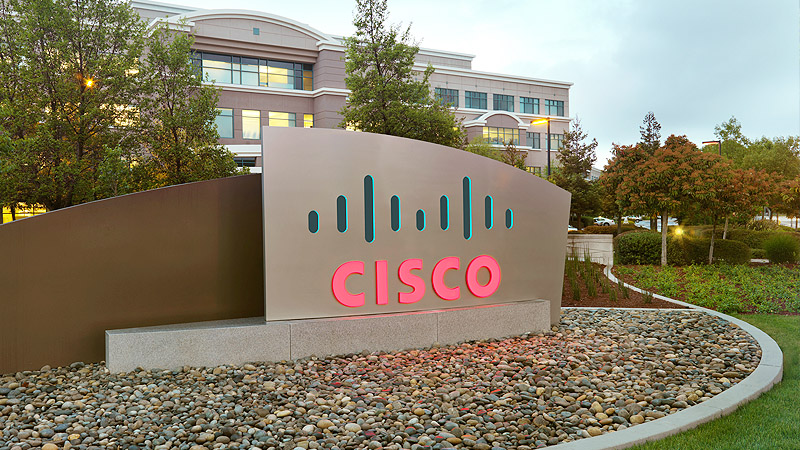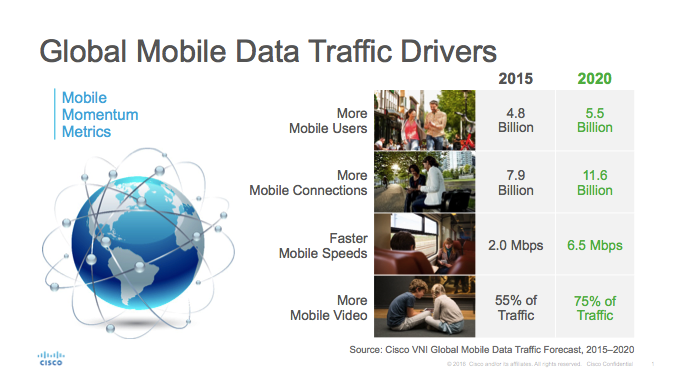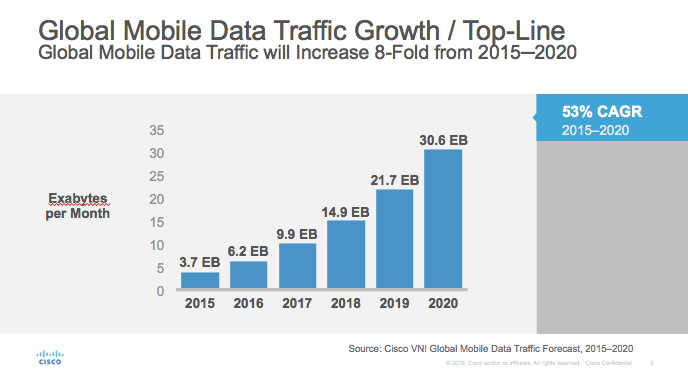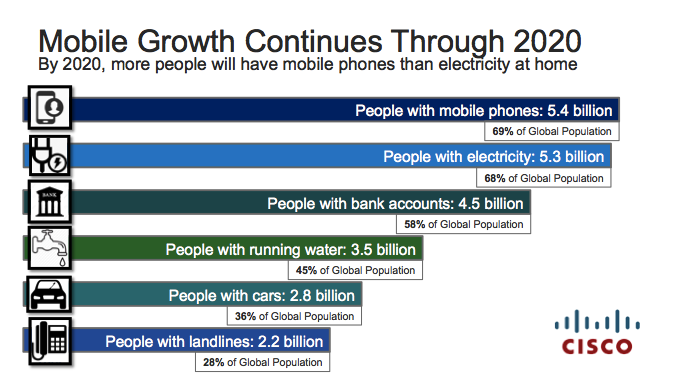SAN JOSE, Calif. – Feb. 3, 2016 – Since 2000, when the first camera phone was introduced, the number of mobile users has quintupled. By 2020, there will be 5.5 billion mobile users, representing 70 percent of the global population[1], according to today’s release of the Cisco Visual Networking Index™ (VNI) Global Mobile Data Traffic Forecast (2015 to 2020). The adoption of mobile devices, increased mobile coverage, and demand for mobile content are driving user growth two times faster than the global population over the next five years. This surge of mobile users, smart devices, mobile video and 4G networks will increase mobile data traffic eight-fold over the next five years.
Smart mobile devices and connections[2] are projected to represent 72 percent of total mobile devices and connections by 2020—up from 36 percent in 2015. Smart devices are forecasted to generate 98 percent of mobile data traffic by 2020. From an individual device perspective, smartphones are dominating mobile traffic. They will account for 81 percent of total mobile traffic by 2020—up from 76 percent in 2015. The proliferation of mobile phones, including “phablets” (a hybrid blend of smartphone and tablet features), is increasing so rapidly that more people will have mobile phones (5.4 billion) than electricity (5.3 billion), running water (3.5 billion) and cars (2.8 billion) by 2020.
Mobile video will have the highest growth rate of any mobile application. Consumer and business users’ demand for higher video resolution, more bandwidth, and processing speed will increase the use of 4G connected devices. 4G connectivity share is projected to surpass 2G by 2018 and 3G by 2020. 4G will represent more than 70 percent of all mobile traffic, and 4G connections will generate nearly six times more traffic per month than non-4G connections by 2020.
“With the ever-increasing billions of people and things that are being connected, mobility is the predominant medium that’s enabling today’s global digitization transformation,” said Doug Webster, vice president of service provider marketing, Cisco. “Future mobile innovations in cellular, such as 5G, and Wi-Fi solutions will be needed to further address new scale requirements, security concerns, and user demands. IoT advancements will continue to fuel tangible benefits for people, businesses, and societies.”
Mobile Data Traffic Projections and Trends:
Global Mobile Data Traffic Shows No Signs of Slowing Down
· By 2020:
o Global mobile data traffic will reach 30.6 exabytes per month—up from 3.7 exabytes in 2015.
o Annual global mobile data traffic will reach 366.8 exabytes—up from 44.2 exabytes in 2015.
· The forecast annual run rate of 366.8 exabytes of mobile data traffic for 2020 is equivalent to:
o 120X more than all global mobile traffic generated just 10 years ago in 2010.
o 81 trillion images (e.g., MMS or Instagram)—28 daily images per person on earth for a year.
o 7 trillion video clips (e.g., YouTube)—more than 2.5 daily video clips per person on earth for a year.
· From 2015 to 2020, global mobile data traffic will grow two times faster than global fixed IP traffic.
· In 2015, 51 percent of total mobile data traffic was offloaded; by 2020, 55 percent of total mobile data traffic will be offloaded.
· By 2020, over 75 percent of the world’s mobile data traffic will be video.
Mobile Devices and Connections Are Getting Smarter
· There will be 11.6 billion mobile-ready devices/connections—including 8.5 billion personal mobile devices and 3.1 billion M2M connections –up from 7.9 billion total mobile-ready devices and M2M connections in 2015.
· Globally, 67 percent of mobile devices/connections will be 'smart' by 2020—up from 36 percent in 2015.
· Globally, 98 percent of mobile data traffic will come from 'smart' devices/connections by 2020—up from 89 percent in 2015.
· Smartphones, laptops, and tablets will drive about 92 percent of global mobile data traffic by 2020—down from 94 percent in 2015. M2M traffic will represent 7 percent of global mobile data traffic by 2020—up from 3 percent in 2015; while basic handsets will account for 1 percent of global mobile data traffic by 2020—down from 3 percent in 2015.
· By 2020:
o 66 percent of mobile devices/connections will be IPv6-capable—up from 36 percent in 2015.
o IPv6 traffic will be 54 percent of total mobile data traffic—up from 13 percent in 2015.
Machine-to-Machine (M2M) Connections and Wearable Devices Continue to Rise
M2M refers to applications that enable wireless and wired systems to communicate with other devices of the same ability (e.g., GPS/navigation, asset tracking, utility meters, security/surveillance video, healthcare monitoring, et al.). Wearable devices can be worn (e.g., smart watches and health monitors) and communicate to the network either directly via embedded cellular connectivity or through another device (primarily a smartphone) via Bluetooth, Wi-Fi, etc. Wearable devices are a subset of the M2M category in the forecast.
· By 2020, M2M connections will represent 26.4 percent of mobile-connected devices—up from 7.7 percent in 2015.
· By 2020, M2M connections will generate 6.7 percent of total mobile traffic—up from 2.7 percent in 2015.
· Global wearables will grow six-fold from 2015 to 2020.
· By 2020, there will be more than 600 million wearable devices in use, up from nearly 97 million in 2015.
Mobile Network Speeds and 4G Connection Growth
· Average global mobile network speeds will increase 3.2 fold from 2015 (2.0 Mbps) to 2020 (6.5 Mbps). Global 4G adoption is the primary catalyst for mobile speed improvements.
· By 2020:
o 4G connections will account for 40.5 percent of all mobile connections–up from 13.7 percent in 2015).
o 3G connections will account for 38.7 percent of all mobile connections—up from 33.7 percent in 2015.
o 2G connections will account for 13.5 percent all mobile connections—down from 52.3 percent in 2015.
· 4G traffic will grow 13-fold from 2015 to 2020.
· By 2020, 4G connections will account for 72 percent of total mobile data traffic—up from 47 percent of total mobile data traffic in 2015.
Wi-Fi Hotspots Are Growing
· Globally, total Wi-Fi hotspots, including home spots, will grow 7X from 2015 (64 million) to 2020 (432 million). Globally, home spots will grow from 57 million (2015) to 423 million (2020).
· In 2015, monthly Wi-Fi offload traffic (3.9 exabytes) exceeded monthly mobile/cellular traffic (3.7 exabytes) for the first time.
· By 2020, 38.1 exabytes Wi-Fi offload traffic will be generated each month, continuing to exceed projected monthly mobile/cellular traffic (30.6 exabytes).
Voice-over-Wi-Fi (VoWi-Fi) Primed for Growth
Given the growth and mobile networking role of Wi-Fi technologies, this year’s study again compares VoWi-Fi to other mobile voice services. Previous VoWi-Fi offerings had limitations that affected adoption and end-user experiences. Today’s carrier-grade VoWi-Fi services can be delivered to non-SIM devices, such as Wi-Fi-only tablets.
· By 2016, VoWi-Fi will exceed VoLTE in the number of minutes used per year.
· By 2018, VoWi-Fi will exceed VoIP in the number of minutes of used per year.
· By 2020, VoWi-Fi minutes of use will account for half – 53 percent – of all mobile IP voice traffic.
· By 2020, the number of Wi-Fi-capable tablets and PCs (1.7 billion) will be more than three times the number of cellular-capable tablets and PCs (548 million).
Regional Mobile Data Traffic Growth Rates (2015–2020)
1. The Middle East and Africa (15-fold growth)
2. Asia-Pacific (9-fold growth)
3. Central and Eastern Europe (8-fold growth)
4. Latin America (8-fold growth)
5. Western Europe (6-fold growth)
6. North America (6-fold growth)
Cisco Mobile VNI Forecast Methodology
The Cisco® VNI Global Mobile Data Traffic Forecast (2015‑2020) relies upon independent analyst forecasts and real-world mobile data usage studies. Upon this foundation are layered Cisco's own estimates for mobile application adoption, minutes of use and transmission speeds. Key enablers such as mobile broadband speed and device computing power are also factored into Cisco mobile VNI projections and findings. A detailed methodology description is included in the complete report (see link below).
Editor's Notes
Cisco also welcomes press, analysts, bloggers, service providers, regulators and other interested parties to use and reference our research with proper attribution, such as "Source: Cisco Visual Networking Index Global Mobile Data Traffic Forecast Update, 2015‑2020."
Cisco defines the following terms:
• Cellular Traffic: comes from a cellular or radio network connection—2G, 3G and 4G.
• Wi-Fi Offload Traffic: refers to traffic from dual mode devices (supports cell and Wi-Fi connectivity, excluding laptops) over Wi-Fi/small cell networks. Offloading occurs at the user/device level when one switches from a cellular connection to Wi-Fi/small cell access.
• Fixed/Wi-Fi Traffic: comes from a wireless connection enabled by some fixed network source, such as a residential Wi-Fi router or public hotspot.
Images and Video
• 2G, 3G, and 4G Mobile Network Shifts (2015-2020).
• Infographic: Cisco Visual Networking Index Global Mobile Data Traffic Forecast Update (2015-2020)
Additional Supporting Resources
• Cisco Visual Networking Index home page
• Cisco Visual Networking Index Mobile Data Traffic blog post: "Major Mobile Milestones – The Last 15 Years, and the Next Five"
• Read the complete Cisco Visual Networking Index: Global Mobile Data Traffic Forecast Update, 2015–2020 white paper.
• Cisco Visual Networking Index: Global Mobile Data Traffic Forecast Q&A, 2015–2020
• Learn more about the free Cisco Visual Networking Index resources
• See the latest Cisco Data Meter results worldwide: http://ciscovni.com/data-meter/index.html
• Follow us on our LinkedIn page for targeted updates and announcements
• For more information about Cisco's service provider news and activities visit the SP360 Blog or follow us on Twitter @CiscoVNI.
• Cisco Service Provider SlideShare presentations
• Cisco Service Provider Mobility Community
• Subscribe to Cisco's SP360 feed
See how the rapid evolution of mobile services to a virtualized cloud environment creates more than $500B in new opportunity by 2019. You can find out more using our Monetization and Optimization Index (MOI). And you can use it to forecast your specific market in cloud, mobile or video services.
Cisco VNI Global Mobile Data Traffic Forecast Update Webcast
Cisco invites press, analysts and bloggers to attend a webcast featuring Cisco executives talking about the global impact of mobile data traffic growth for service providers, organizations and consumers. The webcast begins at 8:00 a.m. (PST) on February 23 and can be accessed by registering at Cisco VNI Global Mobile Data Traffic Forecast Update (2015-2020).
About Cisco (NASDAQ: CSCO) is the worldwide leader in IT that helps companies seize the opportunities of tomorrow by proving that amazing things can happen when you connect the previously unconnected. For ongoing news, please go to http://newsroom.cisco.com.
Cisco and the Cisco logo are trademarks or registered trademarks of Cisco and/or its affiliates in the U.S. and other countries. A listing of Cisco's trademarks can be found at www.cisco.com/go/trademarks. Third-party trademarks mentioned are the property of their respective owners. The use of the word partner does not imply a partnership relationship between Cisco and any other company.
[1] The world’s projected population by 2020 will be 7.8 billion people (source: United Nations).
[2] Smart devices are defined as connections with advanced computing/multimedia capabilities and a minimum of 3G connectivity.






